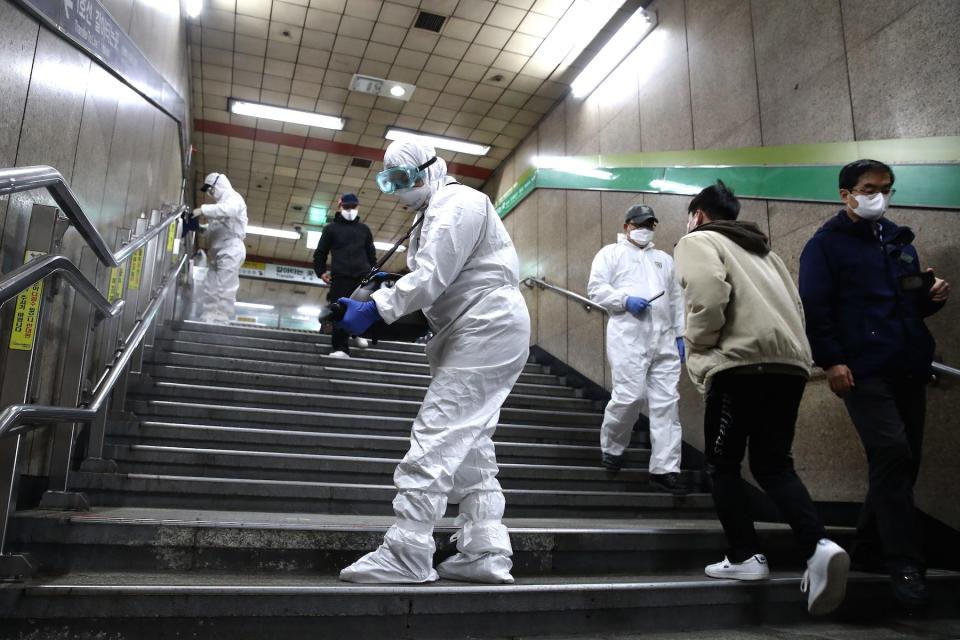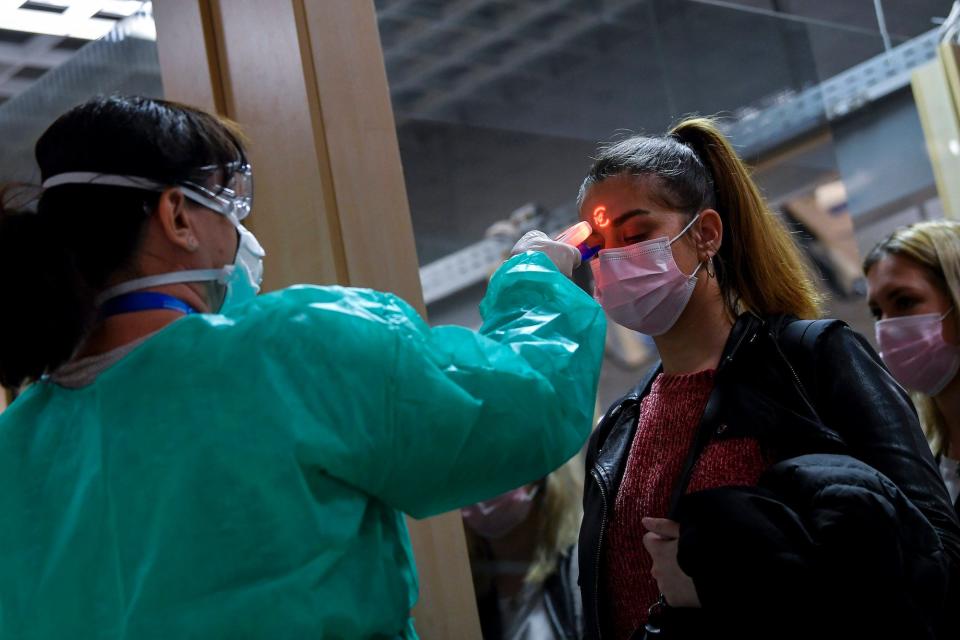As the coronavirus outbreak worsens outside of China, hopes of containing it are diminishing

Associated Press
The coronavirus outbreak that originated in China has spread to at least 40 other countries. South Korea, Italy, and Iran have seen a dramatic spike in cases.
More than 50 deaths have been reported outside of mainland China.
Health experts say this is a critical week to contain the spread of the virus.
For the latest case total and death toll, see Business Insider's live updates here.
For a few weeks in February, it seemed the coronavirus outbreak had passed its apex. The World Health Organization said on Monday that the epidemic had peaked and plateaued in China between January 23 and February 2, and a recent study found that the largest number of Chinese patients were showing symptoms on February 1.
But over the last few days, the epidemic has taken a worrisome turn: The number of cases outside of mainland China more than doubled in just four days, jumping from around 1,150 on Friday to more than 2,600 on Tuesday.
More than 1,200 people are now infected in South Korea, and 12 have died. Italy has confirmed 11 deaths and a case total of 322. Iran, meanwhile, has nearly 140 cases, but 19 people have died.
"There now are a number of countries where the virus has been introduced and there clearly was some spread," William Schaffner, an infectious disease specialist at the Vanderbilt University School of Medicine, told Business Insider on Tuesday. "Those countries are still trying to contain it, but we're not certain how successful they're going to be."
Schaffner said he's much more nervous this week than last.
"There's no numerical definition of a pandemic — like beauty, it's in the eye of the beholder," he said. "I think we're right on the edge of it."
Drastic upticks in South Korea, Italy, and Iran
On Sunday, South Korean president Moon Jae-in said the country faced "a grave turning point" in its efforts to contain the outbreak.
A few days earlier, a 61-year-old member of a controversial fringe religious group — the Shincheonji Church of Jesus — was reported to have spread the virus to dozens of other worshippers. More than half of the coronavirus patients in South Korea were either members of that church or had contact with a member as of Monday.
The New York Times reported that worshippers at the Temple of the Tabernacle of the Testimony, where the 61-year-old woman had attended an event, were forbidden to wear face masks.

Chung Sung-Jun/Getty Images
Italian authorities, meanwhile, have struggled to find "patient zero" there. The country's case total skyrocketed over the weekend; only three cases has been confirmed there as of Friday. Most of the Italian patients are in the northern region of Lombardy, which is home to Milan.
Italy has banned public events in 10 municipalities, closed public buildings, and restricted transport in the northern region.
"We are asking basically that everyone who has come from areas stricken by the epidemic to remain under a mandatory house stay," Italy's health minister, Roberto Speranza, said in a press conference on Saturday.
While Iran has reported fewer cases than in Italy or South Korea, many health experts think the full case count there is higher than the official total so far, given the death count. Iran now has the highest number of coronavirus deaths outside of China.
At least five Middle Eastern countries — Bahrain, Iraq, Kuwait, Lebanon, and Oman — have linked their own infections to travelers from Iran. Over the weekend, several other Middle Eastern countries — including Afghanistan, Armenia, Pakistan, and Turkey — restricted travel to and from Iran.
'This is a critical week'
Despite the climbing number of international coronavirus cases, around 97% of the more than 80,000 total cases are in China. The World Health Organization has thus far hesitated to call the virus a pandemic, since the designation also takes into account the severity of illnesses caused by a virus. A recent study from the Chinese Center for Disease Control found that around 80% of cases have been mild.
Still, the coronavirus has spread to 40 other countries and killed more than 2,800 people in total.
A pandemic refers to a virus that has escaped its origin country, been introduced to a number of others, and is spreading in those nations in a sustained fashion. An epidemic, by contrast, is more regionally contained.
"It's clear that the virus has escaped to other countries," Schaffner said. "It has been introduced and it has spread, but it's not clear that it is spreading in a sustained fashion."
But that might not be the case for long.
"This is a critical week," Schaffner said. "We could change our mind within days."
Richard Martinello, an associate professor of infectious disease at the Yale School of Medicine, told Business Insider on Tuesday that the number of countries with cases of the virus was still "relatively limited."
"Of course, as the days have gone on over the last week or two, we've seen that list actually grow quite a bit," he added. "At some point, it won't be surprising if we're seeing transmission here in the United States."
The Centers for Disease Control and Prevention said on Tuesday that the outbreak will likely spread to more communities in the US, and that Americans should "prepare for the expectation that this might be bad."
CDC officials said that any travelers returning from China, South Korea, Italy, Japan, or Iran who develop a fever, cough, or shortness of breath should seek medical help and self-isolate.
Travel could still fuel the spread of the virus
The spread of the virus to other countries "was always very, very likely," Schaffner said.
"Many of the countries bordering China did not put in an absolute travel ban," he added. "South Korea is now paying the price for that."

Zsolt Czeglédi/MTI / AP
South Korea issued a travel ban for all foreign nationals who had visited China's Hubei province in the prior two weeks on February 2. A few days earlier, more than half a million South Koreans signed a petition calling for a ban on all Chinese visitors.
But such policies may have come too late, Martinello said.
"This virus has already circulated so widely that, at best, travel bans may slow things down a little," he said. "Without real draconian measures, it's essentially impossible to prevent further spread of this."
At the moment, he added, people shouldn't refrain from traveling internationally. But the risk of contracting the virus while traveling, he said, is "not zero and it is increasing with time."
"We are losing the ability to focus on just one country," Martinello said. "As we see further spread of this virus, it does increase the risk that those who are traveling internationally may be in contact with somebody who is connecting from some other country where they may have picked this up."
The outbreak can still be contained, but time is running out
Last week, the World Health Organization warned that the window of opportunity to contain the outbreak was narrowing.

Associated Press
Schaffner said countries might now want to consider testing people who have recently returned from hotspots outside of China.
"Suppose they've come back from Italy, particularly northern Italy — I would open the door to that testing," he said.
But travelers from countries like Spain, which have only reported a handful cases, wouldn't require a test, he added.
Although there's some evidence that the virus can be transmitted when patients aren't showing symptoms, Schaffner said doctors shouldn't be too concerned about identifying asymptomatic patients.
"The more frequent that phenomenon is, the more difficult it is to control it. But there's nothing we can do about it," he said. "So forget about it. Work on what you can deal with."
Read the original article on Business Insider

